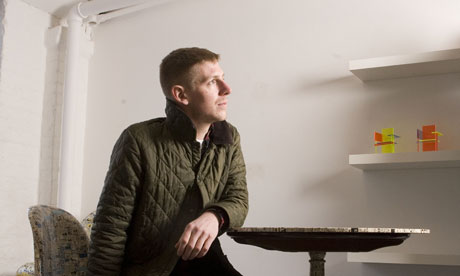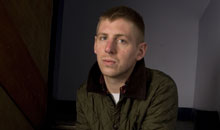Interview: Matthew Darbyshire
Matthew Darbyshire has come a long way in a short time. Just over a year ago he was flat on his back recovering from a series of serious operations on his spine; now, he is preparing for his debut at Tate Britain - a prospect the former builder finds "quite terrifying"

From building site to art gallery: Matthew Darbyshire prepares for his upcoming show at Tate Britain
Walking into Blades House, Matthew Darbyshire's breakthrough 2008 exhibition at Gasworks in Kennington, South London, you could almost have taken it for a genuine noughties bachelor pad.
Based on a floor plan from the new apartment block next door, it was replete with trendy furniture, the pristine white walls adorned with vivid pop-art portraits and an ersatz graffiti mural. Adhering to the same brash colour palette of oranges, lime greens and fuchsia pinks, a Paul Smith shirt hung in the bedroom while a pair of Arne Jacobsen bistro chairs – or were they Tesco knock-offs? – were tucked with meticulous precision under the bright, salsa-red dining table.
Who would live in a house like this? Probably only a Patrick Bateman-esque psycho killer. And yet Blades House was not so far-fetched. Every item in the exhibition – bar the odd reproduction that Darbyshire made himself – was loaned to him from current retail collections when he cheekily told manufacturers he was conducting a survey of modish contemporary furniture. Instead, he used the pieces to assemble a brilliant critique of the democratisation of design: the process by which hospital waiting rooms or fast food restaurants have increasingly come to resemble TV game show studios or city boys' condos, and vice versa.
"It was based on this idea of cultural homogenisation, that the whole world's beginning to look the same," says Darbyshire, who claims Blades House's eerie ambience was a serendipitous side-effect. "I'm not trying to herald a quaint back-to-basics aesthetic. I'm just trying to highlight this advent of democratic, non-specific design – and maybe help unravel it."
Perhaps unsurprisingly, Darbyshire has a design background. At the age of 15, he took over his uncle's business making and selling furniture. He had planned to study product design at university but an art foundation course convinced him he could combine his technical skills with his artistic impulses and spent four years doing sculpture at Slade, funded by a sideline in building renovation.
Then, the week after completing his MA at the Royal Academy, he collapsed. Three operations were required to remove a couple of slipped discs from his spine and he was laid up for almost two years. "I think it was a build-up from years of being an idiot, taking on jobs on my own lifting plasterboards upstairs and hanging ceilings," he reflects glumly. Only last year was he able to return to his studio, and he still can't bend or lift – a cruel blow for such a large-scale, hands-on artist.
Still, the handicap hasn't stymied his ambition. His next exhibition space will be the main Octagon of the Tate Britain, as part of February's Triennial – "quite a frightening prospect". His plan for the gallery is inspired by Tate Britain's "uncanny" architectural similarity to Stalin's 1955 Palace of Culture and Science in Warsaw.
 Darbyshire's Tate exhibition is inspired by the Palace of Culture and Science in Warsaw
Darbyshire's Tate exhibition is inspired by the Palace of Culture and Science in Warsaw "I was in Warsaw last year and I was fascinated by the notion of a palace of culture. Through web research, that took me to The Public in West Bromwich, which is the massive new arts space designed by Will Alsop – the one that looks like a magenta fishbowl. The comparison I liked is that, to this day, no one really knows what the Palace of Culture and Science is for, and The Public has been met with the same sort of criticism. It's open now and the staff are very friendly but there's not much happening. It's the archetypal New Labour building!
"My idea is that the Tate becomes the Palace becomes The Public. As our gift to Poland, we've got Will Alsop to give the palace a New Labour facelift." This 'Russian doll' effect will involve reproductions of the palace's socialist-realist monuments being engulfed by the frivolous pink corrugated cladding and wiggly neon lights of Alsop's The Public.
His subsequent project, due to show at the Hayward in London in May, explores similar themes. He intends to build a fairground-style funhouse, but as if it had been commissioned by the Arts Council. "After you've passed through the Ron Arad mirrored tunnel and negotiated the Herzog & de Meuron wobbly handrails, you end up in a 'wellness centre' with gym balls rather than a ball pool."
Instead of being painted in gaudy carnival hues, Darbyshire's funhouse will borrow its antiseptic colour scheme from contemporary public buildings, incorporating the ubiquitous concrete and frosted glass facades of every new committee-designed library or academy across the country. The kicker? "Nothing works. There's a sign up saying funding's been pulled."
Darbyshire's whole oeuvre functions as a criticism of current arts funding. "You basically have to be a facilitator for a marginal group to get money for your project and there's not really any opportunity for anything remotely idiosyncratic – it's regarded as indulgent. But I didn't sign up as a civil servant. Having said that, my own work's not that whimsical or masturbatory, so I sometimes wonder why I'm getting in a state about it."
You might be curious as to what Darbyshire's own living room looks like. Is he crippled with anxiety when entering Ikea, for example? He laughs. "Luckily my house is furnished by the landlord."
What about friends who might have been offended to see their prized Noguchi beehive lamp deployed sarcastically in Blades House? "I was a bit worried that some would take it personally, but instead of feeling embarrassed they've asked me if they can have the furniture when I've finished with it. Maybe if I had to buy my own stuff I'd realise I was a victim too and come back with a Corbusier chaise longue."
No comments:
Post a Comment